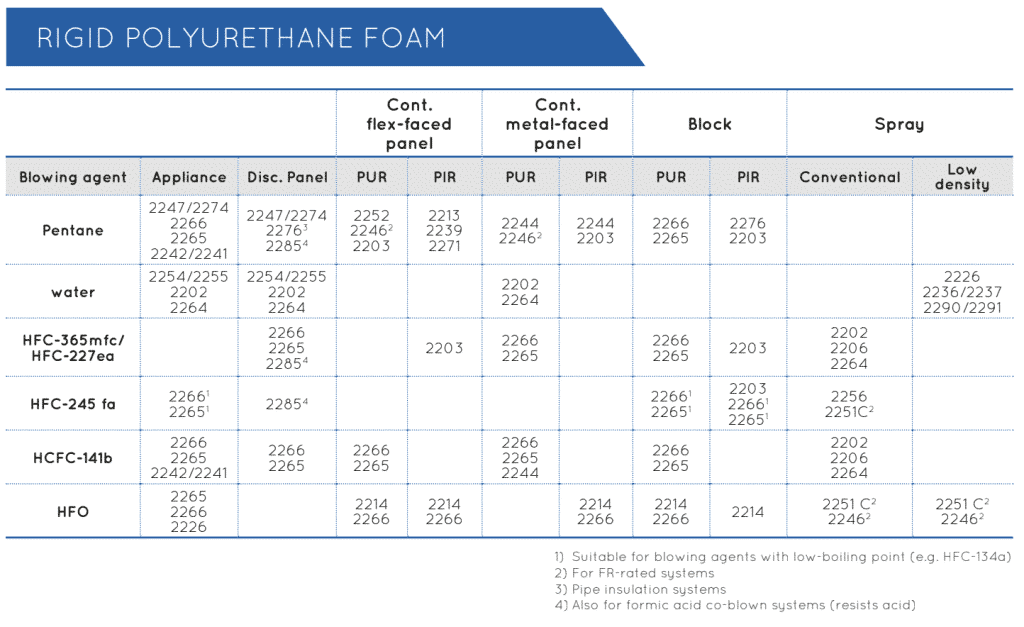Silicone surfactants are copolymers composed of a silicone base (the nonpolar component) and polyethers (the polar component), typically polyethylene oxide (EO) and polypropylene oxide (PO) chains.
These surfactants function as surface tension reducers in products, mitigating pressure disparities among bubbles of varying sizes. Their application aims to enhance bubble stability and achieve a medium-to-small cell size. Within this context, we can classify surfactants into two categories: foam stabilizers and cell regulators.
Foam stabilizers are surfactants employed in critical PU formulations, those that, due to their chemical nature, exhibit minimal stability. In such cases, a surfactant with stabilizing properties becomes essential to assist during the foaming process when gases expand.
When gases expand, there’s a risk that the resulting foam may become unstable and collapse before solidifying into a consistent structure. The surfactant plays a pivotal role in these scenarios by stabilizing the foaming process until the cell walls harden, effectively preventing collapse.
In this article, our focus will be on silicone stabilizers for rigid foam.
Functions of silicone stabilizer formulations for rigid foam
These additive ranges primarily serve three functions in the polyurethane foam process:
- Stabilization
Rigid polyurethane formulations require an additive to provide the essential stability since the foaming process inherently lacks stability.
- Regulation of cell size
The foam’s cellular structure must maintain uniformity and homogeneous distribution. Cells are generated during the mixing process between isocyanate and polyol.
- Emulsifier of formulation components
Rigid polyurethane formulations require silicone surfactants to address incompatibility issues between different formulation components. Their emulsification capabilities are essential for ensuring optimal performance during the foam process.
Characteristics of silicone stabilizers for rigid foam
Concentrol formulations are renowned for their industry-appreciated features. Beyond their principal attribute of low thermal conductivity, they exhibit qualities such as adherence to coating materials, outstanding mechanical resistance, fire resistance, hysteresis or resilience, and more.
- Thermal insulation
Rigid polyurethane foam stands as one of the finest thermal insulation materials, effectively resisting heat conduction. Lower lambda (λ) values indicate greater insulating capabilities and, a priori, a better foam.
This value is highly requested by customers who produce rigid foam for insulating panels or for rigid injected polyurethane foam, making it an ideal choice for applications such as household appliances or construction, among others.
- Dimensional stability
As foam expands, small CO₂ bubbles are generated and act as a foaming agent remaining inside the rigid foam. The growth rate in both directions (horizontal and vertical) can be different, causing the gas bubbles to be not perfectly round, but oval.
To measure dimensional stability, we evaluate the compression force (FtC, Force to Crush) of horizontally and vertically cut pieces, with values closer to 1 indicating uniform growth in all directions and, consequently, superior foam quality.
It’s important to note that these two characteristics often exhibit an inverse relationship. In other words, when enhancing thermal conductivity, compromises may be necessary in terms of dimensional stability, and vice versa.
- Fire resistance
Fire resistance measures a material’s capacity to resist combustion. Various methodologies assess this property, but for rigid PU foam, the commonly employed method is the German standard DIN 4102 (B1), also known as TEST B2.
During this test, specimens of specific dimensions are placed vertically within a test cabinet and exposed to a 20 mm high flame on both the surface and edge of the foam. The B2 rating is granted if the flame’s tip doesn’t reach a marked reference line on the foam within 20 seconds.
These rigid foams typically have densities ranging from 30 to 40 kg/m³ and are typically manufactured using physical foaming agents. Consequently, the selected surfactant must possess not only regulatory and cell-stabilizing properties but also emulsifying capabilities to ensure effective mixing with the polyurethane system and physical foaming agent of choice.
Concentrol references
Concentrol offers a range of silicone stabilizers for rigid polyurethane foams, primarily found in the STB PU-22XX line. Below, you’ll find details for each formulation.
To select the optimal stabilizer for a specific polyurethane system, it’s essential to consider both chemical and process-related requirements. Chemical requirements are linked to the type of polyol, isocyanate, and foaming agent used, with consideration for the influence of other components like catalysts. Process-related factors include efficient mixing, curing conditions, and casting fluidity.
Concentrol boasts a team of professionals always available to address customer needs and provide expert guidance in choosing the most suitable formulation.



